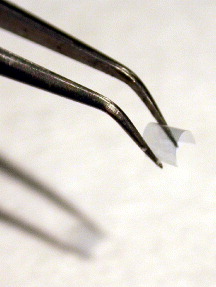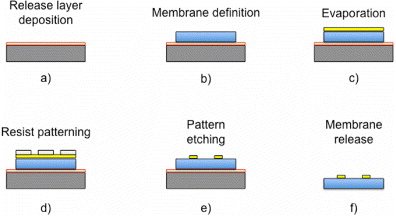Metaflex: Flexible Sheets that Bend Light, Making Objects Invisible
Image courtesy http://iopscience.iop.org
I’d long thought invisibility was reserved for fictional characters like Harry Potter, but it turns out researchers are actively trying to develop materials that create the effect. So-called “metamaterials allow researchers to manipulate electromagnetic waves beyond the boundaries of what physics allows in natural materials. As well as promising better solar cells and high-resolution microscope lenses, metamaterials have also been used to create so-called invisibility cloaks, in which electromagnetic waves are bent around an object as if it simply weren’t there” (Cass). Metamaterials must be constructed out of elements smaller than the wavelength of the electromagnetic radiation being manipulated, which means that “invisibility cloaks (and most metamaterial devices in general) only work with wavelengths longer than those found in visible light, such as radio and microwave frequencies. Metamaterials designed to work with optical wavelengths are built on rigid and fragile substrates, and as a result they’ve been confined to the lab” (Cass). Not too long ago, researchers at the University of St. Andrews created sheets of a flexible metamaterial that can manipulate visible light, taking a big step towards bringing metamaterials out of the lab and onto the market.
The new metamaterial is called “Metaflex” for obvious reasons, and it’s not exactly a piece of cake to manufacture. First, researchers deposit a sacrificial layer atop a rigid substrate, to prevent subsequent layers from binding to it. Then, a sheet of flexible, transparent plastic gets laid down and “a lithographic process, similar to that used to make silicon chips, creates a lattice of gold bars, each 100 to 200 nanometers long and 40 nanometers thick, on top of the polymer. (These bars act as ‘nanoantennas’ that interact with incoming electromagnetic waves.) The Metaflex material is then bathed in a chemical that releases the polymer from the layer below and from the rigid substrate” (Cass). Variations in length and spacing of nanoantennas let Metaflex interact with different wavelengths of light.
Image courtesy http://iopscience.iop.org
The largest sheets researchers have produced so far are smaller than a postage stamp at five by eight millimeters, and they are only four micrometers thick. Those samples may seem small when your goal is to cloak an entire person, but Metaflex is by far the largest sample of an optical metamaterial ever made. Researchers believe that Metaflex can be scaled up for industrial production because it is flexible. Being able to shape Metaflex into cylinders or spherical sections would allow for the creation of “curved super lenses that could manify objects so small that they currently can’t be seen with optical lenses due to diffraction effects” (Cass). ” Metaflex can be fabricated flat and bent into shape.
It’s thought that sheets of Metaflex could be layered to create the first optical metamaterial with significant thickness. A multilayered composite could potentially allow the material to respond to multiple optical wavelengths of light (Cass). Researchers are working to create these stacks of Metaflex, and plan to examing how the material responds when twisted, stretched, and bent.
Image courtesy http://iopscience.iop.org
The material could be embeded in fabric to make highly adaptive camoflouge, or perhaps one day even an invisibility cloak. The researchers have demonstrated that Metaflex could be incorporated into contact lenses. I’ll be interested to see what happens when we can hide entire cities!
I’ve filed Metaflex under metal and wood because it’s flexible.
Cited:
Cass, Stephen. “A Bendable, Light Bending Material.” TechnologyReview.com. 11/08/10. Accessed 11/16/10. URL.
More information: http://iopscience.iop.org/1367-2630/12/11/113006/fulltext



















[…] This post was mentioned on Twitter by a c lind. a c lind said: RT @ARCHITERIALS: Metaflex: Flexible Sheets that Bend Light, Making Objects Invisible http://bit.ly/hETm3a […]
Leave a Wordpress Comment: